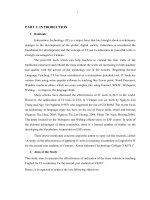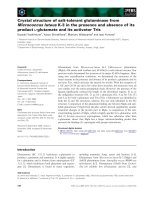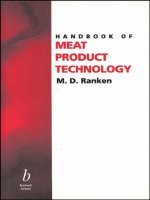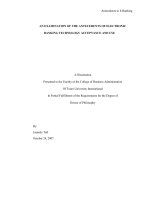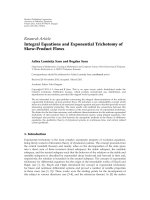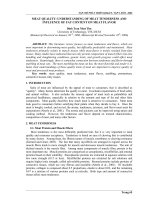hand book of meat product technology
Bạn đang xem bản rút gọn của tài liệu. Xem và tải ngay bản đầy đủ của tài liệu tại đây (9.75 MB, 245 trang )
HANDBOOK
OF
MEAT PRODUCT
TECHNOLOGY
M.D.
RANKEN
BSc Tech, CChem, MChemA, MFC,
FRSC, FTFST, FInstM
Consultant Food Technologist
b
Blackwell
Science
2000 Blackwell Science Ltd
Editorial Offices:
Osney Mead, Oxford OX2 OEL
25 John Street, London WClN 2BL
23 Ainslie Place, Edinburgh EH3 6AJ
350 Main Street. Malden
MA 02148 5018, USA
54 University Street. Carlton
Victoria 3053. Australia
10, rue Casimir Delavigne
75006 Paris, France
Other Editorial Offices:
Blackwell Wissenschafts-Verlag GmbH
Kurfiirstendamm 57
10707 Berlin, Germany
Blackwell Science KK
MG Kodenmacho Building
7-10 Kodenmacho Nihombashi
Chuo-ku. Tokyo 104. Japan
The right of the Author to be identified as the
Author of this Work has been asserted in
accordance with the Copyright, Designs and
Patents Act 1988.
All rights reserved. No part of this
publication may be reproduced, stored in a
retrieval system, or transmitted. in any form
or by any means, electronic, mechanical,
photocopying. recording or otherwise, except
as permitted by the UK Copyright, Designs
and Patents Act 1988, without the prior
permission of the publisher.
First published 2000
Set in 10i12pt Times
by DP Photosetting, Aylesbury, Bucks
Printed and bound in Great Britain by
MPG Books Ltd, Bodmin, Cornwall
The Blackwell Science logo is a trade mark
of
Blackwell Science Ltd, registered at the
United Kingdom Trade Marks Registry
DISTRIBUTORS
Marston Book Services Ltd
PO Box 269
Abingdon
Oxon OX14 4YN
(Orders:
Tel: 01235 465500
Fax: 01235 465555)
USA
Blackwell Science, Inc.
Commerce Place
350 Main Street
Malden. MA 02148 5018
(Orders:
Tel: 800 759 6102
781 388 8250
Fax: 781 388 8255
Canada
Login Brothers Book Company
324 Saulteaux Crescent
Winnipeg. Manitoba R3J 3T2
(Oudeus:
Tel: 204 837-2987
Fax: 204 837-31161
Australia
Blackwell Science Pty Ltd
54 University Street
Carlton, Victoria 3053
(Oudeus:
Tel: 03 9347 0300
Fax: 03 9347 5001)
A catalogue record for this title is available
from the British Library
ISBN 0-632-05377-1
Library of Congress
Cataloging-in-Publication Data
Ranken. Michael D.
M.D. Ranken.
Handbook of meat product technology/
p. cm.
Includes bibliographical references and
index.
ISBN 0-632-05377-1 (pbk.)
1. Slaughtering and slaughter-houses.
2. Meat.
I.
Title.
TS 1960. R25 2000
664.9-dc21 99-059649
For further information on
Blackwell Science, visit our website:
www. blackwell-science.com
Preface
The need has been evident for some time for a short handbook of meat
product technology, expressed in the language and style of modern science
and technology. The majority of the older texts are written by and in the
style of the private or small-scale butcher with good practical experience,
knife in hand, of meat animals and meat. They give practical instruction on
the employment of the butcher’s practical understanding to make the best
commercial use of the meat which he has before him. But the present-day
college or university graduate, appointed to manage a factory department
or a complete meat factory, where all of those skills may be employed on
the large scale and subdivided among different groups of people, does not
usually himself (or, often enough, herself) enjoy the same practical skills
and experience. His (or her) skills are science-based and hence there is a
need to understand the meat technology from that scientific basis.
This handbook is an attempt to meet that need. It attempts to give proper
weight on the one hand to the craft element in all modern and traditional
meat product manufacturing and on the other hand to the scientific reasons
(so
far as they are known) for those practices, their best results and their
occasional failures.
NOTE
Reference is made occasionally in the text to particular machines, ingre-
dients, etc., giving the names of manufacturers or brands of which the writer
has knowledge or experience. In no case should any such reference by name
to a material, ingredient, machine or process be taken to imply endorse-
ment of the named product over any similar product.
M.D.
Ranken
Hythe, January
2000
Acknowledgements
I
must express deep gratitude to the Leatherhead Food Research Asso-
ciation for all the opportunities which
I
had when
I
was there from 1970
until 1984, to formulate the ideas and to discover the information on which
this handbook is based.
I
include warm thanks to my colleagues in the Meat
and Fish Products Laboratory at that time for their contributions to the
work and the thinking which we did together. Those former colleagues
include, particularly, Percy Barnet, Dr Gar Evans, Mats Henriques, Anne
Manning (then Anne Lewin), Gilbert Oliphant, Dr Sue Valentine (then Sue
Richards) and the late Dr John Wood.
I
have been much influenced by two books which are standard works in
the field: Frank Gerrard’s
Sausage and Small Goods Production
and the
successive editions of Ralston Lawrie’s
Meat Science.
I
am very grateful for
all that they have taught me.
Figures 9.1 and 9.2 are from
Food Industries Manual,
25th edition, with
permission of the Editors. Figure
1.4
is reproduced from
Food Standards
Committee Report
on
Meat Products
1980,
with permission of the Con-
troller of The Stationery Office, London. Figure
8.1
is reproduced by per-
mission of Urschel International Ltd, Leicester. Figure 8.4 is by permission
of DMV bv, Veghel, The Netherlands.
I
owe thanks also to a number of people now more closely associated with
the meat products industry than I, who have given generously of their time
and knowledge in checking that the information here is accurate and up to
date: Professor Keith Anderson, University of North London; Professor
Joe Buckley, University College, Cork; Dr Ron Kill, Micron Laboratories;
Professor David Ledward, Reading University; Mr Fred Mallion, Wor-
shipful Company of Butchers; Professor Geoff Mead, Royal Veterinary
College; Mr Michael Nightingale and Mr Nick Church, Fibrisol Ltd; Dr
Robert Shaw, Campden and Chorleywood Food Research Association; Dr
Tom Toomey, Ventress Technical Services Ltd; and Dr Jean-Luc Ven-
deuvre, Centre Technique de la Salaison, Charcuterie et Conservation de la
Viande, Maisons Alfort, France.
Finally, to all the other people whom
I
no longer properly remember who
have contributed materials and ideas, often no doubt unwittingly, to this
handbook, my apologies but many thanks.
Contents
Preface
Acknowledgements
xi
xii
Part One Principles
1
Manufacturing Meat
Sources
Cattle
Pig
Sheep
Poultry
Other species
Manufacturing cuts
‘Noble’ and ‘less noble’ meats
Reasons for making meat products
Lean meat
Mechanically recovered meat or mechanically
Head meat
Fat
Connective tissue
Offals
Components of meat and their properties
separated meat
2
Processing Principles
Moisture retention
Water content of meat
Measurement of moisture retention
Effects of pH
Effects of added water, salt and phosphates
Modes of action of salt and phosphates
Penetration and distribution of water and salts
Effects of fat on moisture retention
Cooking losses from fatty tissue
Fat retention
3
3
3
4
4
4
5
5
5
7
8
8
12
13
13
19
21
25
25
26
27
28
28
30
32
33
34
34
vi
CONTENTS
Binding of free fat
Fat in pastes and pMs
Other questions
Connective tissue
Meat binding
Measurement
Exudate formation
Meat exudate and fat binding
Binding at low temperature
Similarities and differences among meats
Binding aids
Processing lean, fat and connective tissue together
3
Curing
General preservation principles
Effects of the main curing ingredients
Salt
Water content and water activity
Nitrite
Ascorbate and erythorbate
Phosphates
Heat
Smoke
Storage temperature
4 Colour and Flavour
Theory
Iridescence
Meat pigments
Chemistry
Colours of meat
Colour of fresh meat
Chemistry
Factors affecting the colour
of
fresh meat
Chemistry
Red or pink colours in cooked uncured meat products
Colour of cured meat, uncooked and cooked
Chemistry
Factors affecting the colour of cured meat
Added colours
Miscellaneous colour problems
Colour of cooked (uncured) meat
39
42
43
43
43
44
44
45
45
45
46
47
49
49
50
50
51
51
57
57
57
58
58
59
59
59
59
59
61
61
62
63
68
68
68
69
69
71
75
76
CONTENTS
vii
Flavour
The flavour of the meat itself
Spoilage
Flavours developed during processing
Added flavours
5
Microbiology
Practical: the main things to know
Microbial growth
Effect of acidity (pH)
Moisture and mould growth
Unwanted microbial growth during manufacturing processes
Positive uses of microbial growth
Control or destruction of microbes
Food poisoning
Practical: the essential things to do
For fresh meat and fish meat products
For cooked meat and cooked meat products
Cooked food
6
Chilling and Freezing
Definitions
Temperature measurement
Effects of freezing
Microbiological effects
Chemical effects
Physical effects
Colour
Drip losses
Cooking losses
Storage life
Chillers, refrigerators
Freezers
Heat transfer from a warmer source
Generation of heat within the product
Re-freezing
Effects on meat properties
Management of the cold chain
Thawing
77
77
77
77
77
79
79
80
80
80
81
82
82
86
87
87
89
89
91
91
91
93
93
93
95
98
98
98
98
99
99
99
99
102
102
103
104
7 Cooking
Advantages of cooking
105
105
CONTENTS
Vlll
Primary advantages
Secondary effects
Water boils at 1OO'C
Protein changes
Cooking losses
Changes above
100°C
Flavour changes
Microbial danger zone
Practical cooking conditions
Source and effectiveness
of
heat
Heating conditions within the product
Changes which occur
on
cooking
Smoking
Canning and heat processing
Heat process values
Special cases
Part
Two
Applications
8
Comminuted Meat Products
Comminution processes
Dicing, etc.
Flaking
Chopping
Mincing (grinding)
Milling
Mechanically recovered meat
Mixing with other ingredients
Burgers, meat balls, re-formed meat: definitions
Burgers
Re-formed meat
Sausages
Fresh sausages
Emulsion sausages
Dried and fermented sausages
Spreadable meat products
Luncheon meat, meat loaf, etc.
Products
9 Cured Meats
Processes
Injection
Tanking or immersion curing
105
106
106
106
107
108
108
109
110
110
110
111
112
112
112
114
117
119
119
119
120
121
122
123
123
124
124
124
125
129
130
131
142
143
143
147
149
149
149
150
CONTENTS
ix
Dry curing
Massaging, tumbling
Smoking
Bacon and ham
Wiltshire process
Ham production
Composition of the finished products
Tongues
Luncheon meats
Dried and fermented sausages
Corned beef
Products
10
Miscellaneous Meat Products
Minced meat and meat preparations
Injected meats
Meat (including poultry) with stuffing
Canned meats
Coated and breaded products
Integrity of the product
Coating
Meat pies
Pastry
Pie fillings
Baking
Cooling
Staling
Freezing
Storage and transport
Mould growth
General
Black pudding (blood sausage)
Products made mainly with offal
Products made with trimmings and some offal
Other products
Products made from trimmings, offal, etc.
11
Controls
-
Manufacturing, Commercial and Legal
Manufacturing controls
Good manufacturing practice
Codes
of
Practice
Commercial controls
Cost control and recipe control
150
150
151
152
152
154
159
161
163
165
167
168
171
171
171
172
172
172
173
173
174
175
178
179
180
180
181
181
181
182
182
183
184
185
187
191
191
191
193
194
194
X
CONTENTS
Controls exercised by retail customers
General food law
Estimation of meat content
Connective tissue
Control via water content
Identification of meat species
Legal controls
Analytical considerations
References and Bibliography
194
195
195
197
197
199
199
200
201
Index
203
Part
One
PRINCIPLES
1
Manufacturing Meat
SOURCES
The main sources of manufacturing meats are noted below.
Cattle
cow
‘Cow beef‘ comes from animals at the end of their useful period of milk
production, usually
5-8
years old at slaughter, when milk yield has begun to
fall (but note that Regulations in the UK relating to BSE prohibit the use of
meat from cattle more than
30
months old).
0
Dairy breeds in the
UK
include Ayrshire, Jersey, Friesian and Holstein;
these are not usually very meaty.
0
‘Dual purpose’ breeds such as Dexter, Red Poll and Shorthorn have
better conformation and meat yield.
Calf
Milk production is a sequel to calving; male calves and many of the females
are surplus to the requirement for new milk cattle. The surplus provides
veal
calves grown to
3-4
months (bobby calf, bobby veal
-
up to
3
months
old).
Steer, bullock
Males grown to meat weights
(450
kg live weight or more); not usually
available for manufacturing, except that in large meat plants they may
provide trimmings and the less ‘noble’ cuts (see below).
0
‘Dual purpose’ breeds, as above, are intended to give females with good
milk production and males with good meat yield.
0
‘Heavy’ breeds (e.g. Aberdeen Angus, Hereford, Charolais), in which
both males and females are grown for meat.
0
Beef
x
dairy crosses constitute the bulk of beef slaughtered in the UK.
4
HANDBOOK
OF
MEAT PRODUCT TECHNOLOGY
Bacon pig
Bred for long backs with low to moderate fat cover. Convert economically
to bacon.
Heavy hog
Fatter and proportionately shorter. Bred for high growth rate and good
feed conversion. Used for mixed manufacture
-
fresh pork, some bacon,
some sausage and pie meat.
‘Continental’ breeds
Tendency to even more fat than the heavy hog.
Boars
The meat of boars which have been used for breeding is usually strongly
tainted with the smell of male sex hormone (‘boar taint’). Young, unca-
strated males, slaughtered at or before puberty, have good feed conversion
and conformation and may be free from this taint.
Sheep
Differences of breed or sex are not significant for manufacturing purposes,
except that ‘ram taint’ may be encountered in the meat of old breeding
rams.
Poultry
Chicken
0
Hens from egg production (‘spent’ hens). Usually about
18
months old,
small, and with relatively poor conformation and meat yield. They are
cheap and are the main source of manufacturing chicken meat.
0
Broilers. The term means suitable for grilling; in the USA it covers birds
up to about 1.5kg dressed weight, but in the UK heavier birds are
included, up to
3-4
kg. Age 6-10 weeks.
0
Broiler breeder hens. These are the parents of broilers after their
productive egg-laying life. They are larger and have better meat yield
than normal egg-layers. Numbers available are relatively small.
MANUFACTURING MEAT
5
Note that:
0
Flavour is stronger but texture is tougher in the older birds (hens versus
broilers).
0
A
small proportion of birds may be grown under ‘free range’ conditions,
some laying birds in ‘pole barns’, etc., but almost all the remainder are
grown intensively, broilers in large open houses, hens in cages.
0
Flavour and texture differences due to breed or growing conditions are
negligible.
Turkey
For domestic sale, carcasses may range down to
2-3
kg dressed weight. For
manufacturing, mainly male birds are used; these are usually
10-15
kg
dressed weight.
Other species
From time to time there may be interest in ensuring that species such as
horse, hippopotamus or kangaroo are not supplied fraudulently in place of
beef. These and other species may be of interest for pet foods, depending on
availability and price.
MANUFACTURING CUTS
‘Noble’ and ‘less noble’ meats
The ‘noble’ cuts are those most highly regarded by chefs and gourmets
because they have:
0
high contents of muscle
0
small amounts of fat, which is on the outside of the meat and
so
can be
easily removed if unwanted
0
low contents of connective tissue or gristle and none in the form of large,
thick pieces
0
small amounts of bone, which can be easily removed.
Meat with these properties is:
0
simple to cook, e.g. by grilling or roasting
0
tender when lightly cooked
0
simple to serve and provides large portions consisting almost entirely of
desirable lean meat
0
highly regarded and therefore highly priced.
6
HANDBOOK
OF
MEAT PRODUCT TECHNOLOGY
‘Noble’ cuts come from the hindquarter of the animal where there are:
0
fewer moving parts
0
simpler bone structure
0
a few large muscles
0
less connective tissue
0
fat deposits mainly on the outside.
The less ‘noble’ cuts have the reverse characteristics from those listed
above and are more likely to be used for manufacturing. They come mainly
from the forequarter, where there are:
0
many and complex moving parts
0
a complex bone structure
0
many, smaller muscles
0
more connective tissue.
Cuts from the belly or flank, where there are no bones to give support in
the live animal, have particularly strong (therefore tough) connective
tissues; there are also more or less thick layers of fat between the muscles.
Figure
1.1
shows how some of these factors apply in typical cuts of beef.
Approx.
Yo
Muscle
~
Fat
~
Connective0
~
Bone
tissue
Round0
Brisket0
Neck0 480
Flank 58
17
25
Fig.
1.1
Composition
of
typical cuts
of
beef.
MANUFACTURING MEAT
7
‘Primal cuts’ of beef as supplied for manufacturing commonly consists of
the forequarter (chuck
+
neck
+
shoulder
+
shin) or ‘Pistola fores’ (fore-
quarter
+
brisket
+
some flank).
Figure
1.2
shows the major cuts of pork.
Loin
\\
Shoulder
\
/
Belly
Fig.
1.2
Main
cuts
of pork
Reasons
for
making meat
products
A
major purpose for converting meat into meat products must be
to modify
or
upgrade the less noble cuts of meat,
together with any edible trimmings
of fat and connective tissue removed from the more noble cuts; and to make
the flavour and texture more acceptable to consumers than they would be if
treated only by the simple cooking and serving methods which are appro-
priate for the noble cuts.
The technical problems which must be dealt with in improving the
acceptability of such meat are:
0
to remove bones
0
to make the connective tissues less objectionable
0
to present the available fat in more acceptable form
0
to leave flavour and nutritive value unimpaired or even improved.
An alternative purpose may be
to preserve the meat.
Here the question
of the ‘nobility’ of the meat may not be
so
important. For bacon and ham
manufacture, for instance, the pigs may be specially selected for properties
relevant to the quality of the final product, such as back fat thickness or low
tendency to PSE (see page
10);
meat without these desirable properties may
be diverted to other products or even to the butchery trade. Preservation
may of course be undertaken in addition to the upgrading described above,
e.g. the canning of luncheon meat. Preservation methods are dealt with in
later chapters.
Economic factors may distort these purposes in special cases; for
example, a sausage factory might be run at full capacity to satisfy an existing
8
HANDBOOK
OF
MEAT PRODUCT TECHNOLOGY
market, even at the cost of using more noble meat as raw material. Such
distortions are likely to be temporary.
COMPONENTS
OF
MEAT AND THEIR PROPERTIES
Lean meat
Lean meat or muscle consists
of
%
a
contractile mechanism
consisting of myofibrillar protein
(actin, myosin, etc.), in the form of many fibrils, fibres and
fibre bundles
10.0
each encased in light tubing or
netting
(connective tissue),
2.0
surrounded by
fluid
(sarcoplasm), consisting of water
(75.0%),
sarcoplasmic protein
(6.0%),
and other soluble
substances including myoglobin (red colour), salts, vita-
mins, etc.
84.5
and some fat, sinews,
nerves, blood vessels,
etc. 3.5
consisting of collagen and elastin
The actin-myosin contractile system is represented simply in Fig. 1.3; a
more detailed diagram of the structure of muscle is given in Fig. 1.4.
Actin Myosin Actin
Direction
of
expansion/contraction
Fig.
1.3
The actin-myosin system
Post-mortem changes
The chemical changes which take place on the death of the animal, changing
muscle into meat, are complicated but fairly well understood. For detailed
discussion see standard textbooks, e.g.
R.A.
Lawrie’s
Meat
Science.
The most important changes are as follows.
MANUFACTURING MEAT
9
Fig.
1.4
Structure of meat at various magnifications.
(a) Effects related to
pH
When normal metabolism and the supply of oxygen to the bloodstream
cease, glycogen (the animal’s energy supply, derived from food) is turned to
lactic acid and the pH falls, normally from
7.0-7.2
to
5.5-6.5.
This process is
known as glycolysis. In abnormal cases the following conditions may occur.
10
HANDBOOK
OF
MEAT PRODUCT TECHNOLOGY
0
PSE
condition
-
pale, soft, exudative
(=
wet) meat.
If
the pH falls very
rapidly (glycogen supply being adequate) because of nervous excite-
ment at the time of slaughter especially in stress-susceptible animals,
(e.g. Pietrain or Danish Landrace pigs), the result is a low pH value (not
abnormally low, but reached quickly while the carcass is still warm).
This leads to precipitation of soluble proteins (sarcoplasmic protein),
poor water binding and pale colour.
0
DFD
condition
-
dry, firm, dark meat.
If
the glycogen supply is low
because of hunger (starvation), exercise (exhaustion), or long-term
stress in the live animal, little lactic acid can be formed and the ultimate
pH is high. This leads to deeper colour, closer texture and better water
binding, but poorer microbiological quality. Other names for the con-
dition are ‘dark cutting’ in beef and ‘glazy’ in bacon.
The avoidance of either of these conditions depends upon good conditions
of transport, lairage and slaughter. The best quality meat comes therefore
from healthy, well fed, unstressed animals.
(b)
Effects related to rigor mortis
On the death of the animal the ATP (adenosine triphosphate) in the
muscles goes to ADP (adenosine diphosphate) and AMP (adenosine
monophosphate), with a release of energy which causes contraction, i.e.
rigor mortis. After a time the muscles relax again, that is, there is resolution
of rigor mortis.
Times for onset and resolution of rigor in different animals are as shown
in Table
1.1.
Table
1.1
Times for onset and resolution of rigor
Approximate time Approximate time
to
onset of rigor
for resolution of rigor
Cattle
Pigs
Turkey
Chickens
12-24h
6-12h
1-2h
1-1
h
2-6d*
1-3d
6-24 h
4-6 h
*
To
14d
for
maximum
tenderness
In chilled meat supplied for manufacturing, these processes have nor-
mally been completed and no problems arise. But if the rigor-resolution
sequence is interrupted by cutting, chilling, freezing or cooking, toughness
may result.
MANUFACTURING MEAT
11
0
Cutting.
Cutting before or during rigor allows muscles to shorten and
may cause toughness when the meat is cooked.
0
Chilling
or
freezing.
Chilling the meat rapidly, immediately after
slaughter (i.e. if the temperature falls to
+
10‘C (50‘F) by the time pH
reaches
c.
5.5
and rigor commences) leads to ‘cold shortening’ and tough
meat. This is a problem with sheep and sometimes cattle, but not
normally with pigs or poultry. The remedy is to chill more slowly or to
use electrical stimulation: see below.
Freezing the meat early in rigor or before rigor commences, when
residual ATP is still present, leads to
‘thaw rigor’:
strong contraction
with toughening when the meat is thawed.
If
the frozen meat is stored
for a long time (months), the ATP gradually disappears and thaw rigor
diminishes.
If
the meat is held at -5°C (23°F) for several hours before
thawing, the chemical changes continue but the meat is unable to
contract and therefore does not toughen.
Freezing after rigor gives no special problems.
Cooking.
If
this is done
before onset
of
rigor
(i.e. immediately after
slaughter) it produces very tender meat (in theory: in practice it may not
be possible to work fast enough and rigor will commence before or
during cooking). Cooking
during rigor
results in tough meat. Cooking
after resolution of rigor
produces tender meat. Tenderness increases
with time before cooking, up to a maximum.
0
The toughness of contracted muscles is probably due to a combination of
two factors:
0
compression of the muscle structure as the actomyosin system contracts,
and
0
contraction and tightening of the connective tissue network in the
muscle sheaths.
Several methods are in use to reduce the toughening due to these effects:
The ‘Tenderstretch’ process:
the carcass is hung from the ‘aitch’ bone
immediately after slaughter
so
that the maximum proportion of the
‘noble’ muscles are stretched, improving their tenderness.
‘Hot’ meat processing.
Salt treatment before rigor prevents contraction
(although ATP is still lost), and gives meat with high water holding
capacity.
Electrical stimulation.
If
the carcass is given electric shocks immedi-
ately after slaughter, this causes muscular contractions which consume
the ATP and glycogen present, leading to rapid onset of rigor mortis.
The meat can then be chilled rapidly without risk of toughening due
to cold shortening. The process is used for frozen lamb and some-
times for beef, to improve the tenderness of frozen carcass meat.
12
HANDBOOK
OF
MEAT PRODUCT TECHNOLOGY
'bone'
or
'whole
'
bone'
There is no evidence of any adverse effect on manufacturing quality.
Electrical stimulation is not used for pork, whose carcasses are not
generally frozen and where there is a danger of causing the PSE
condition.
Mechanically recovered meat (MRM) or mechanically
separated meat (MSM)
Mechanically recovered meat or MRM is the usual description of this
material in the
UK
but it may also be known as mechanically separated
meat or
MSM.
It is the residual meat recovered by machines from bones
already more or less well trimmed by knife (see Fig.
1.5).
The machines
force the softer meat under pressure through perforated screens (e.g.
Baader, Beehive, Bibun) or through channels formed in other ways
(Protecon).
I
-
-/'v
-
-
yvv
-
1
M
/v
-MEAT
M
"n
including tendons
'meat'
-
PERIOSTEUM
-
HARD BOhE
i
(compact oone,
4
dense bone)
-
MARROW
HRM may be expected
to
contain:
1
+
some
2
only
MRM may be expected to contain
:
1
+
2
+
4
+
some
3
Residue from MRM may be expected
to
contain:
3
+
some
1
+
some
2
+
some
4
Fig.
1.5
Diagram of a bone with adherent meat.
MANUFACTURING MEAT
13
MRM consists of the meat and fat which were on the bones, finely sub-
divided by passage through the machine. Some machines also extract
marrow from within the bones.
The connective tissue content is not higher than that of the most carefully
hand-removed meat (HRM). Bone fragments are granular in form, not
splintery, and are normally few; the actual proportion depends on the yield
extracted from the machine. Current EU regulations require calcium
content not greater than
0.02%
and no bone fragments of size greater than
0.5
mm.
The BMMA and CLITRAVI Codes of Practice (see page 193) prohibit
the production of MRM or MSM from poultry heads and feet or from the
heads, feet, tails (except bovine tails) and leg bones of other animals.
Following the BSE crisis in the late 1980s, regulations now also require that
MRM from bovine or ovine animals:
shall be made only on premises licensed for the purpose, and
shall not contain any spinal cord or material from vertebral columns.
Head meat
Under normal circumstances head meat, or ‘cheek meat’, is a legitimate
material for use in meat products, but there are certain specific problems
which must be attended to:
In the
UK,
under the regulations in force following the BSE crisis, meat
from cattle or sheep heads is counted as ‘class
I1
specified risk material’
(with a very few exceptions) and prohibited from use in the preparation
of any human food; the use of pig head meat is not restricted.
However carefully prepared, head meat is likely to be relatively highly
contaminated with bacteria and should be handled and used accord-
ingly. (The reasons include proximity of the nasal organs whose function
in the live animal is to filter out harmful bacteria, thereby concentrating
them, and the relatively large number of knife cuts required, which
spread contamination and encourage microbial growth.)
Head meat is also likely to contain the salivary glands from inside the
animal’s mouth. These glands contain enzymes (amylases) whose
function is to convert starches to sugar as part of the animal’s digestive
process. A product made with head meat and any starchy material such
as cornflour, potato or rusk may undergo rapid flavour changes due to
the production of sugar, and texture may also be affected.
The word ‘fat’ may be used in two different senses, which must be carefully
distinguished.
14
HANDBOOK
OF
MEAT PRODUCT TECHNOLOGY
0
In meat products technology ‘fat’ usually means
fatty
tissue,
as opposed
to lean meat or connective tissue. This is a cellular structured material
whose main content is ‘fat’ in the other sense of the word. Examples are
given in Table
1.2.
Table
1.2
Tissue fats in beef and pork
Source or
location of fat Special names
Remarks
Beef Pork
Deposits on the
carcass
Subcutaneous Body butter Back There is a layer of
subcutaneous fat over the
whole carcass. In the case of
pork back, the layer is thick
enough
to
be separated and
used independently
Head
Deposits in the
carcass
Lining the body
cavity
Around:
Intestines
Stomach
Heart
Kidneys
Genitals
Trimmings
Intramuscular
lntermuscular
Jowl
Peritoneal, suet
Ruffle, Flare
mesenteric, gut
Caul, omentum
Pericardial
KKCF (kidney
knob and channel
fat)
Cod Cod
Marbling
Head fats are also sometimes
separated
Removed during preparation
of lean meat for other
purposes
Considered a sign of good
quality in the meat trade;
probably not technically
significant.
Not
removable by
trimming. In well trimmed lean,
including
3%
intermuscular
lntermuscular fat is contained
within the muscles and is not
visible
MANUFACTURING MEAT
15
0
'Fat' also means 'chemical fat'
or
lipid.
This is the main component of
fatty tissue, the contents of the fatty tissue cells. The term is also used
technologically to indicate
rendered
fats
-
lard, dripping and tallow, also
vegetable oils, cooking oils, manufactured shortenings, butter and
margarine. Examples of these are given in Table
1.3.
Table
1.3
Rendered fats, cooking oils, etc.
Type of fat or oil Examples Remarks
Rendered fat Beef dripping
Block suet
Beef tallow, mutton tallow
Lard
'Free fat' (see page
34)
Butter
Vegetable Olive, cottonseed, groundnut,
cooking oil soya, etc.
Vegetable Includes proprietary bakery fats
shortening
Margarine
From internal fats and some body
fats.
'Premierjus'
= first quality
Commercial shredded suet may
consist of rendered beef fat,
mixed with cereal (max. 17% in
Poorer grades from inedible raw
materials (and note
BSE
restrictions in UK)
From pork fat; sometimes other
edible pork material. 'Greaves' is
the material remaining after a
rendering process
u
K)
Made from milk. Contains 16%
water (legal limit in EU and
elsewhere)
Chemically similar
to
rendered
animal fats but usually liquid at
working temperatures
Made from vegetable oils by
chemical hardening
(hydrogenation)
to
make them less
liquid, more plastic or solid (see
page 176 for relevance
to
pastry).
Some compound cooking fats may
contain water
Made with similar properties
to
vegetable shortening; may be
coloured yellow. Domestic
margarine made with similar
properties
to
butter.
All
contain
water (16% in EU and elsewhere)


